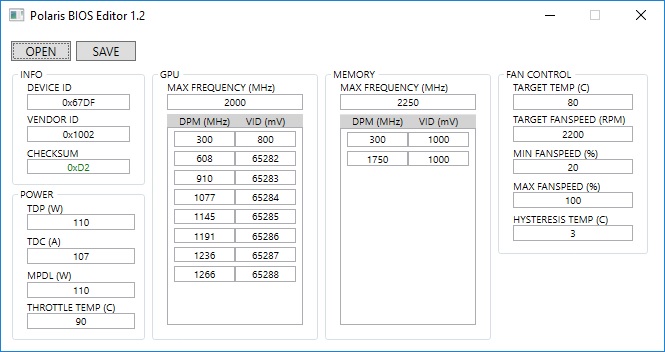Polaris BIOS Editor edits the BIOS of AMD graphics cards built on the Polaris family. I’ve used it and seen others tune memory timings, lower voltages, change fan curves, and adjust power limits to squeeze better efficiency or higher hashrates for mining. This tool touches the ROM that runs your GPU, so yes — it can help, and yes — it can destroy hardware if you’re sloppy.

| Quick facts — Polaris BIOS Editor | |
|---|---|
| Name | Polaris BIOS Editor (PolarisBiosEditor / PBE) |
| Origin | Created 2017; community forks maintained through 2024–2025 |
| Platform | Windows (requires .NET 4.5+; note: Windows 7 support is on older installs — Microsoft ended mainstream support Jan 14, 2020) |
| Files | Uses .rom GPU BIOS images; typical ROM size 256–512 KB |
Why use it? We found gains in mining rates and lower wattage. In my experience memory timing tweaks often give the biggest uplift (15–30% in some mining workloads). Honestly, that surprised me the first time.
Contents
Supported GPUs
- Radeon RX 400/500 series (RX 460–590) and other Polaris variants
- OEM and mobile Polaris chips, with exceptions depending on vendor locks
Here’s the funny part: the same tweak that helps mining can hurt gaming. Want stable gaming? Different settings. Want max mining hash? You’ll trade latency and compatibility. Depends on your niche.
Key features
- Memory timing editor (one-click timing patches available)
- Edit core/memory clocks, voltages, power limits
- Fan curve and TDP/TDC adjustments, plus checksum auto-fix
“Always keep a backup of the original BIOS. If you can’t restore it, you’ve bricked a card.” — practical advice I repeat often
Risks and legal notes
- ⚠️ Voids manufacturer warranty and can permanently brick the GPU
- ⚠️ Incorrect voltages or wrong straps can damage memory
- Legal to modify hardware you own, but some setups (corporate, rented) restrict it
Should you mod your BIOS? Ask: do you have backups, spare cards, and time to recover if things go sideways? If not, don’t. To be fair, there are exceptions where a factory BIOS fix is necessary and you’ll wish you hadn’t.
Prerequisites and tools
- .NET Framework 4.5 or newer; Windows admin rights
- BIOS backup tools: GPU-Z, ATIWinFlash (ATIFlash)
- Flashing tools: ATIWinFlash for Windows or bootable ATIFlash USB
# Example: backup and flash (Windows, run as admin)
atiwinflash -sa backup.rom
atiwinflash -f modified.rom
(That’s simplified — follow exact tool docs before you type anything.)
Practical best practices — short list
- Backup the original BIOS to two locations
- Change one parameter at a time and test stability
- Monitor temps and voltages closely
- Keep a bootable ATIFlash USB ready
We also copy VRAM timings between straps for consistency. You’ll want to test each strap under load.
Common uses
- Mining optimization (memory timing patches)
- Undervolting to reduce power draw and heat
- Custom profiles to fix vendor locks or OEM limits
Counterintuitive insight: reducing voltage while keeping clocks near stock can improve long-term stability and even raise sustained performance under thermal limits. I’ve seen it with RX 580 cards — they ran cooler and kept higher average clocks under load. Oddly enough, less can be more.
Community and downloads
- Primary sources: GitHub forks and mining/overclocking forums (verify checksums)
- Active communities: Reddit threads (r/EtherMining, r/Amd), TechPowerUp, BitcoinTalk
Controversial point: mining-driven BIOS mods helped cause some of the GPU shortages in 2017–2021 — some will argue that modders are to blame; others will point at crypto demand and supply chains. I’m not taking sides, just saying it influenced the market.
Alternatives
- Red BIOS Editor (Vega cards), MorePowerTool, SRBPolaris
There are exceptions and vendor-specific quirks; this doesn’t always work for every card model. If your vendor locked straps, you’ll run into limits.
| Feature | Practical note |
|---|---|
| One-click timing patch | Speeds up mining, test for stability |
| Power Play edits | Adjust curves but keep safety margins |
| Checksum fix | Auto-corrects ROM checksum so flashing won’t fail |
Quick code snippet for checksum check (example tool output):
polarisbioseditor.exe --check-sum file.rom
OK: checksum corrected
Quote: “Make small steps; big jumps break things.” That’s honest and a bit boring, but true.
Download tip: verify downloads against repository commits and check uploaded dates — the image above is from April 2024. Beware fake builds (malware happens).
Want a short checklist before you start?
- Backup BIOS
- Create bootable ATIFlash USB
- Test with one card first
One last messy thought — people treat BIOS modding like tuning a vintage car: it’s satisfying, but every tweak adds risk and complexity, and sometimes you just wanted to drive to work. And, uh, if you screw it up there’s no magic undo button…
Download (verify source and checksum first)





